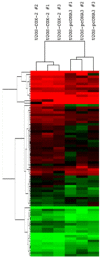Analysis of gene expression in cyclooxygenase-2-overexpressed human osteosarcoma cell lines
- PMID: 25705166
- PMCID: PMC4330262
- DOI: 10.5808/GI.2014.12.4.247
Analysis of gene expression in cyclooxygenase-2-overexpressed human osteosarcoma cell lines
Abstract
Osteosarcoma is the most common primary bone tumor, generally affecting young people. While the etiology of osteosarcoma has been largely unknown, recent studies have suggested that cyclooxygenase-2 (COX-2) plays a critical role in the proliferation, migration, and invasion of osteosarcoma cells. To understand the mechanism of action of COX-2 in the pathogenesis of osteosarcoma, we compared gene expression patterns between three stable COX-2-overexpressing cell lines and three control cell lines derived from U2OS human osteosarcoma cells. The data showed that 56 genes were upregulated, whereas 20 genes were downregulated, in COX-2-overexpressed cell lines, with an average fold-change > 1.5. Among the upregulated genes, COL1A1, COL5A2, FBN1, HOXD10, RUNX2, and TRAPPC2are involved in bone and skeletal system development, while DDR2, RAC2, RUNX2, and TSPAN31are involved in the positive regulation of cell proliferation. Among the downregulated genes, HIST1H1D, HIST1H2AI, HIST1H3H, and HIST1H4C are involved in nucleosome assembly and DNA packaging. These results may provide useful information to elucidate the molecular mechanism of the COX-2-mediated malignant phenotype in osteosarcoma.
Keywords: cell proliferation; cyclooxygenase 2; invasion; migration; osteosarcoma; overexpression.
Figures


Similar articles
-
Cyclooxygenase-2 promotes cell proliferation, migration and invasion in U2OS human osteosarcoma cells.Exp Mol Med. 2007 Aug 31;39(4):469-76. doi: 10.1038/emm.2007.51. Exp Mol Med. 2007. PMID: 17934334
-
MiR-9 is overexpressed in spontaneous canine osteosarcoma and promotes a metastatic phenotype including invasion and migration in osteoblasts and osteosarcoma cell lines.BMC Cancer. 2016 Oct 10;16(1):784. doi: 10.1186/s12885-016-2837-5. BMC Cancer. 2016. PMID: 27724924 Free PMC article.
-
P50-associated COX-2 extragenic RNA (PACER) overexpression promotes proliferation and metastasis of osteosarcoma cells by activating COX-2 gene.Tumour Biol. 2016 Mar;37(3):3879-86. doi: 10.1007/s13277-015-3838-8. Epub 2015 Oct 17. Tumour Biol. 2016. PMID: 26476537
-
Overexpression of COX-2 in human osteosarcoma cells decreases proliferation and increases apoptosis.Cancer Res. 2006 Jul 1;66(13):6657-64. doi: 10.1158/0008-5472.CAN-05-3624. Cancer Res. 2006. PMID: 16818639
-
MicroRNA-338-3p inhibits tumor growth and metastasis in osteosarcoma cells by targeting RUNX2/CDK4 and inhibition of MAPK pathway.J Cell Biochem. 2019 Apr;120(4):6420-6430. doi: 10.1002/jcb.27929. Epub 2018 Nov 28. J Cell Biochem. 2019. PMID: 30484892
Cited by
-
Prognostic and Clinicopathologic Significance of Discoidin Domain Receptors in Different Human Malignancies: A Meta-Analysis.Gastrointest Tumors. 2021 Aug 5;8(4):177-186. doi: 10.1159/000517503. eCollection 2021 Oct. Gastrointest Tumors. 2021. PMID: 34722471 Free PMC article. Review.
-
AC093797.1 as a Potential Biomarker to Indicate the Prognosis of Hepatocellular Carcinoma and Inhibits Cell Proliferation, Invasion, and Migration by Reprogramming Cell Metabolism and Extracellular Matrix Dynamics.Front Genet. 2021 Dec 3;12:778742. doi: 10.3389/fgene.2021.778742. eCollection 2021. Front Genet. 2021. PMID: 34925460 Free PMC article.
-
Analysis of Gene Expression in Human Dermal Fibroblasts Treated with Senescence-Modulating COX Inhibitors.Genomics Inform. 2017 Jun;15(2):56-64. doi: 10.5808/GI.2017.15.2.56. Epub 2017 Jun 15. Genomics Inform. 2017. PMID: 28638310 Free PMC article.
-
Single-cell analysis reveals the loss of FABP4-positive proliferating valvular endothelial cells relates to functional mitral regurgitation.BMC Med. 2024 Dec 20;22(1):595. doi: 10.1186/s12916-024-03791-4. BMC Med. 2024. PMID: 39707349 Free PMC article.
-
Regulation of Osteosarcoma Cell Proliferation, Migration, and Invasion by miR-143 and miR-199a Through COX-2 Targeting.Dose Response. 2024 Jun 20;22(2):15593258241264947. doi: 10.1177/15593258241264947. eCollection 2024 Apr-Jun. Dose Response. 2024. PMID: 38912334 Free PMC article.
References
-
- He JP, Hao Y, Wang XL, Yang XJ, Shao JF, Guo FJ, et al. Review of the molecular pathogenesis of osteosarcoma. Asian Pac J Cancer Prev. 2014;15:5967–5976. - PubMed
-
- Luetke A, Meyers PA, Lewis I, Juergens H. Osteosarcoma treatment - where do we stand? A state of the art review. Cancer Treat Rev. 2014;40:523–532. - PubMed
-
- Longhi A, Errani C, De Paolis M, Mercuri M, Bacci G. Primary bone osteosarcoma in the pediatric age: state of the art. Cancer Treat Rev. 2006;32:423–436. - PubMed
-
- Smith WL, Garavito RM, DeWitt DL. Prostaglandin endoperoxide H synthases (cyclooxygenases)-1 and -2. J Biol Chem. 1996;271:33157–33160. - PubMed
-
- El-Badawi ZH, Muhammad EM, Noaman HH. Role of immunohistochemical cyclo-oxygenase-2 (COX-2) and osteocalcin in differentiating between osteoblastomas and osteosarcomas. Malays J Pathol. 2012;34:15–23. - PubMed
LinkOut - more resources
Full Text Sources
Other Literature Sources
Research Materials
Miscellaneous
